国际商务谈判(英文)教案讲义 chapter 1 International Business Negotiation
- 格式:doc
- 大小:29.50 KB
- 文档页数:5
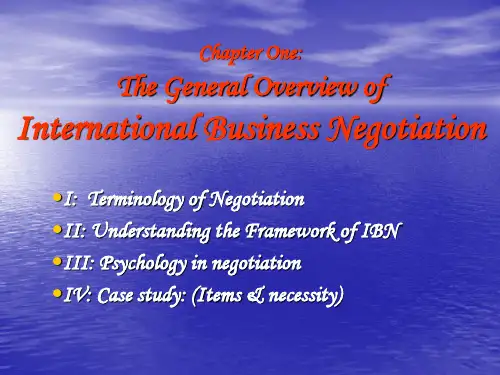
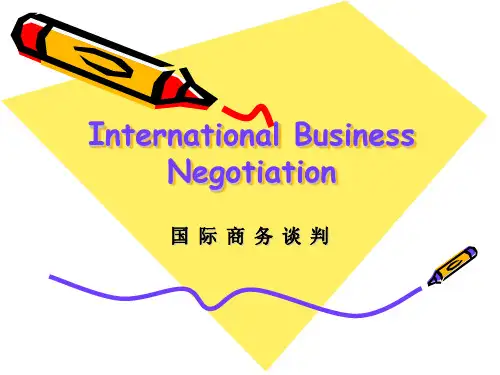
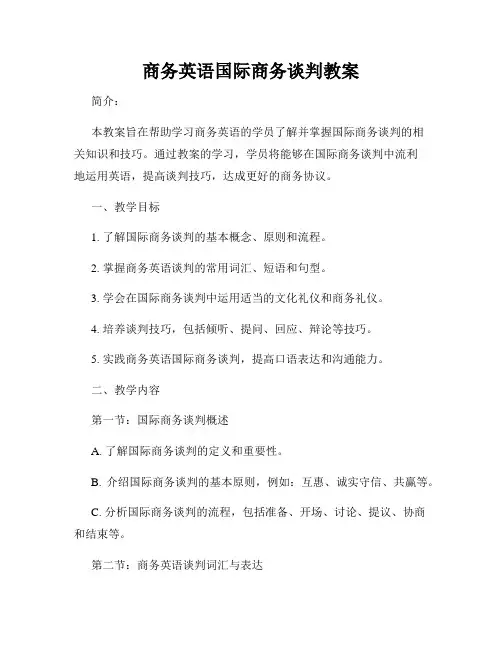
商务英语国际商务谈判教案简介:本教案旨在帮助学习商务英语的学员了解并掌握国际商务谈判的相关知识和技巧。
通过教案的学习,学员将能够在国际商务谈判中流利地运用英语,提高谈判技巧,达成更好的商务协议。
一、教学目标1. 了解国际商务谈判的基本概念、原则和流程。
2. 掌握商务英语谈判的常用词汇、短语和句型。
3. 学会在国际商务谈判中运用适当的文化礼仪和商务礼仪。
4. 培养谈判技巧,包括倾听、提问、回应、辩论等技巧。
5. 实践商务英语国际商务谈判,提高口语表达和沟通能力。
二、教学内容第一节:国际商务谈判概述A. 了解国际商务谈判的定义和重要性。
B. 介绍国际商务谈判的基本原则,例如:互惠、诚实守信、共赢等。
C. 分析国际商务谈判的流程,包括准备、开场、讨论、提议、协商和结束等。
第二节:商务英语谈判词汇与表达A. 学习常用的商务英语谈判词汇和短语,例如:offer, counteroffer, negotiation, compromise, agreement等。
B. 掌握商务英语谈判句型,例如:I propose...; We suggest...; Our position is...等。
C. 练习商务英语谈判对话,模拟真实的商务谈判场景。
第三节:文化礼仪和商务礼仪A. 了解不同国家和地区的文化差异对商务谈判的影响。
B. 学习在国际商务谈判中适应文化差异的礼仪和注意事项。
C. 分析跨文化沟通的误解和解决方法,培养跨文化谈判的敏感性和灵活性。
第四节:谈判技巧与策略A. 掌握谈判中的基本技巧,例如:倾听、提问、回应、辩论等。
B. 学习谈判策略和战术,例如:时间压力、信息收集、权力平衡等。
C. 分析谈判中的利益分析和权力分析,了解各方的需求和立场。
第五节:实践与案例分析A. 进行商务英语国际商务谈判的实践演练,学员分组进行角色扮演。
B. 分析实际商务谈判案例,并讨论谈判结果和相关的经验教训。
三、教学方法1. 配合教材讲解,介绍相关理论知识和实际案例。
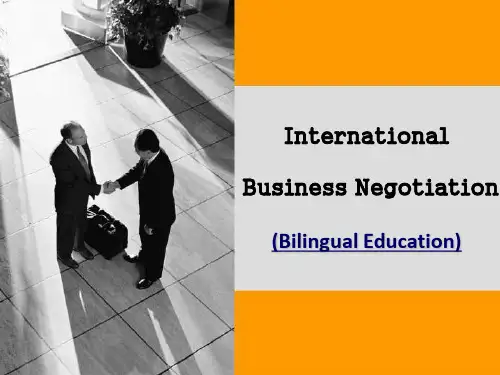
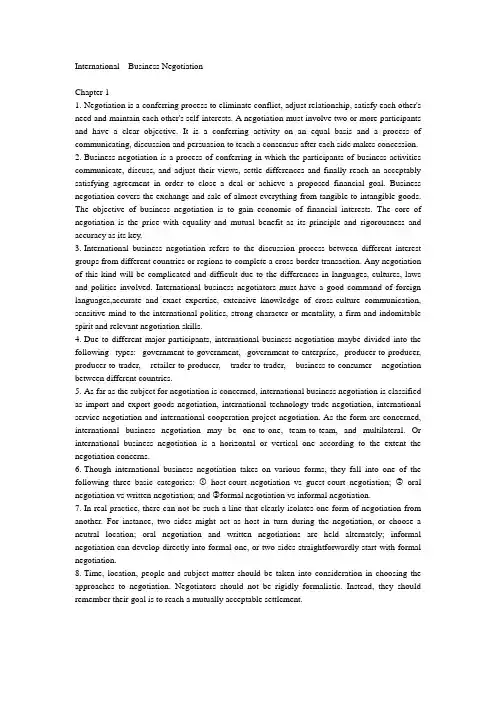
International Business NegotiationChapter 11.Negotiation is a conferring process to eliminate conflict, adjust relationship, satisfy each other's need and maintain each other's self-interests. A negotiation must involve two or more participants and have a clear objective. It is a conferring activity on an equal basis and a process of communicating, discussion and persuasion to teach a consensus after each side makes concession.2.Business negotiation is a process of conferring in which the participants of business activities communicate, discuss, and adjust their views, settle differences and finally reach an acceptably satisfying agreement in order to close a deal or achieve a proposed financial goal. Business negotiation covers the exchange and sale of almost everything from tangible to intangible goods. The objective of business negotiation is to gain economic of financial interests. The core of negotiation is the price with equality and mutual benefit as its principle and rigorousness and accuracy as its key.3.International business negotiation refers to the discussion process between different interest groups from different countries or regions to complete a cross-border transaction. Any negotiation of this kind will be complicated and difficult due to the differences in languages, cultures, laws and politics involved. International business negotiators must have a good command of foreign languages,accurate and exact expertise, extensive knowledge of cross-culture communication, sensitive mind to the international politics, strong character or mentality, a firm and indomitable spirit and relevant negotiation skills.4.Due to different major participants, international business negotiation maybe divided into the following types: government-to-government, government-to-enterprise, producer-to-producer, producer-to-trader, retailer-to-producer, trader-to-trader, business-to-consumer negotiation between different countries.5.As far as the subject for negotiation is concerned, international business negotiation is classified as import and export goods negotiation, international technology trade negotiation, international service negotiation and international cooperation project negotiation. As the form are concerned, international business negotiation may be one-to-one, team-to-team, and multilateral. Or international business negotiation is a horizontal or vertical one according to the extent the negotiation concerns.6.Though international business negotiation takes on various forms, they fall into one of the following three basic categories: ①host-court negotiation vs guest-court negotiation; ②oral negotiation vs written negotiation; and ③formal negotiation vs informal negotiation.7.In real practice, there can not be such a line that clearly isolates one form of negotiation from another. For instance, two sides might act as host in turn during the negotiation, or choose a neutral location; oral negotiation and written negotiations are held alternately; informal negotiation can develop directly into formal one, or two sides straightforwardly start with formal negotiation.8.Time, location, people and subject matter should be taken into consideration in choosing the approaches to negotiation. Negotiators should not be rigidly formalistic. Instead, they should remember their goal is to reach a mutually acceptable settlement.。
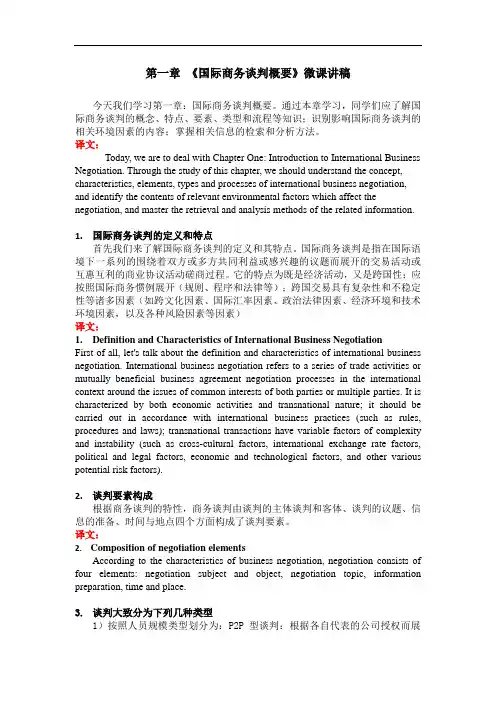
第一章《国际商务谈判概要》微课讲稿今天我们学习第一章:国际商务谈判概要。
通过本章学习,同学们应了解国际商务谈判的概念、特点、要素、类型和流程等知识;识别影响国际商务谈判的相关环境因素的内容;掌握相关信息的检索和分析方法。
译文:Today, we are to deal with Chapter One: Introduction to International Business Negotiation. Through the study of this chapter, we should understand the concept, characteristics, elements, types and processes of international business negotiation, and identify the contents of relevant environmental factors which affect the negotiation, and master the retrieval and analysis methods of the related information.1.国际商务谈判的定义和特点首先我们来了解国际商务谈判的定义和其特点。
国际商务谈判是指在国际语境下一系列的围绕着双方或多方共同利益或感兴趣的议题而展开的交易活动或互惠互利的商业协议活动磋商过程。
它的特点为既是经济活动,又是跨国性;应按照国际商务惯例展开(规则、程序和法律等);跨国交易具有复杂性和不稳定性等诸多因素(如跨文化因素、国际汇率因素、政治法律因素、经济环境和技术环境因素,以及各种风险因素等因素)译文:1.Definition and Characteristics of International Business NegotiationFirst of all, let's talk about the definition and characteristics of international business negotiation. International business negotiation refers to a series of trade activities or mutually beneficial business agreement negotiation processes in the international context around the issues of common interests of both parties or multiple parties. It is characterized by both economic activities and transnational nature; it should be carried out in accordance with international business practices (such as rules, procedures and laws); transnational transactions have variable factors of complexity and instability (such as cross-cultural factors, international exchange rate factors, political and legal factors, economic and technological factors, and other various potential risk factors).2.谈判要素构成根据商务谈判的特性,商务谈判由谈判的主体谈判和客体、谈判的议题、信息的准备、时间与地点四个方面构成了谈判要素。
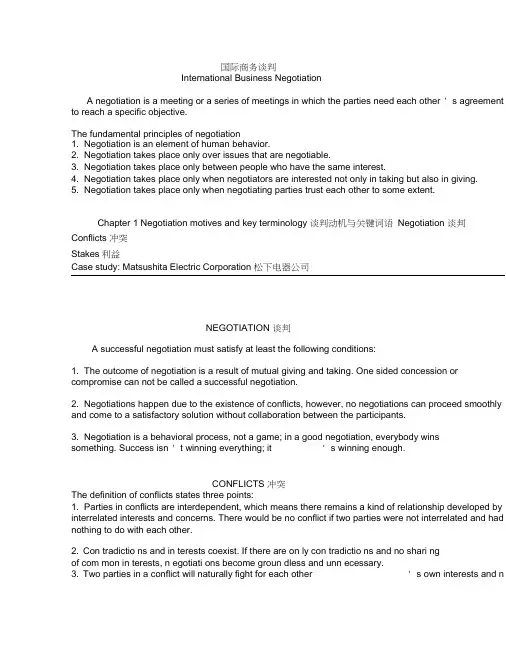
国际商务谈判International Business NegotiationA negotiation is a meeting or a series of meetings in which the parties need each other ' s agreement to reach a specific objective.The fundamental principles of negotiation1. Negotiation is an element of human behavior.2. Negotiation takes place only over issues that are negotiable.3. Negotiation takes place only between people who have the same interest.4. Negotiation takes place only when negotiators are interested not only in taking but also in giving.5. Negotiation takes place only when negotiating parties trust each other to some extent.Chapter 1 Negotiation motives and key terminology 谈判动机与关键词语Negotiation 谈判Conflicts 冲突Stakes利益Case study: Matsushita Electric Corporation 松下电器公司NEGOTIATION 谈判A successful negotiation must satisfy at least the following conditions:1. The outcome of negotiation is a result of mutual giving and taking. One sided concession or compromise can not be called a successful negotiation.2. Negotiations happen due to the existence of conflicts, however, no negotiations can proceed smoothly and come to a satisfactory solution without collaboration between the participants.3. Negotiation is a behavioral process, not a game; in a good negotiation, everybody winssomething. Success isn ' t winning everything; it ' s winning enough.CONFLICTS 冲突The definition of conflicts states three points:1. Parties in conflicts are interdependent, which means there remains a kind of relationship developed by interrelated interests and concerns. There would be no conflict if two parties were not interrelated and had nothing to do with each other.2. Con tradictio ns and in terests coexist. If there are on ly con tradictio ns and no shari ngof com mon in terests, n egotiati ons become groun dless and unn ecessary.3. Two parties in a conflict will naturally fight for each other ' s own interests and nevery effort to gain more from the other side, as a result it will reduce gain of interestsexpected in itially.STAKES利益Stakes are the value of ben efits that may be gained or lost, and costs that may bein curred or avoided. Four points n eed to be clarified:1. Negotiation parties will either gain the interests they expect to win from then egotiati on or lose what they hope to attai n, which in dicates that the talks are pert inent to releva nt parties ' own affairs and in terests. Only whe n a party has stakes conn ected with the issues to be talked, can it become actively engaged in the negotiation.2. Free lunch is not provided at the n egotiati on table, in ano ther word, to get what is desired, both parties have to pay for the gaining at either high cost or low cost depe nding on how well n egotiators man age the situati on.3. The n egotiators will have to decide how much of stakes can be gained and whether a particular gain is the one that a party desires for. They will also have to decide how much they may gain if they choose opti on A in stead of opti on B.4. Negotiators will have to compare and bala nee the relati on betwee n the curre nt in terests and long term in terests or un derly ing desires in order to make decisi on on satisfy ing long term interests at the cost of current interests.Effective negotiati ng (VCD)成功谈判Who s who in Effective NegotiationThe compa niesLevien SA , based in Brussels, Belgium.It is an intern ati onal compa ny which manu factures specialist paints and dyes.In its head office it has a small IT function which the company has decided to outsource.Okus IT, based in Swindon, in the South of En gla nd.They specialize in managing IT projects and taking over the IT departments of theirclie nt compa ni es.The n egotiati onOkus have sent a detailed writte n proposal to Levie n.The meet ing has bee n arran ged to n egotiate the terms of any agreeme nt.In particular the following two issues are likely to be sticking points:1. StaffingLevien would like to protect the jobs of their current IT team.They want Okus to employ the four members of the team, and are under pressure from the unions to make sure outsourcing contracts like this do not lead to redundancies.Okus, on the other hand, will not want totake on Levien ' s whole team.They already have project engineers based in Swindon.2. PricingOkus have proposed two levels of IT support: Level AA fixed monthly price which will cover all support work (daily maintenance and customer support) and specified project work (hardware and software upgrades, training. Etc.) Level BA lower monthly invoice based on just support work. Any additional project work will be logged and then added to the invoice the following month.1. Preparing the groundThe peopleAndrew Carter is Export Sales Manager for Okus IT. He has made the initial contact with Levien. He has met one of the Levien team, Sean, before.Karen Black is a Project Manager at Okus IT. She has prepared the specifications for this contract. This is the first time she has been involved in negotiating an overseas outsourcing contract. She is anxious about the meeting.Francoise Quantin is the current IT Manger at Levien. She is about to be promoted to Head of Logistics. She is keen that her IT team are protected.Sean Morrissey is from Levien ' s main subsidiary in Chicago. He has been sent to the Brussels Office to develop Levien ' s procurement policy.The negotiationAs the VCD begins, Andrew and Karen have arrived at Levien 'osffices and are waiting to meet Francoise and Sean.Script 1Karen Black and Andre Carter fail to communicate before they meet the Levin team.A =Andrew K =Karen F =Fran?oise S =SeanA: You sure you don ' t want one, Karen?K: Not for me.A: Of course, I don ' t know Francoise at all, but you ___ 'wviethgSoetyou about negotiating with him in Dallas two years ago, didn ' t I?K: I ' m sure you did, An drew. Can we just focus on the final package? We mustn . ' t They' re going to __ , but we ___ .A: That' s right. Sean was Head of Procurement at TEC in Atlanta.K: What we must keep in mind is _____ if they push us on staff cuts.A: Oh, we don ' t need to worry about that, Karen. We ________ . Se^hjjulsow are you?S: Good to see you aga in, An drew. Atla nta, was n ' t it?A: Dallas, actually.S: Right, three years ago.A: Two.S: Yeah, sure. You two know each other, right?F: You must be Karen Black. I ' m Francoise Quantin. Welcome to Lebvien.K: we ve spoken on the phone, haven ' t we? This is Andrew Carter, ourA: Sorry, I thought you two already knew each other.S: Well, ____ . Can we …?F: Before we start, would you like a coffee?K: That would be ni ce.F: Milk?K: Yes, please.Script 2Kare n Black and Andre Carter are better prepared for their meeti ng with the Lev in team.A: There you go.K: tha nks.A: So, we ' ll wait fdJielm to respond to our proposal.K: Yes, we know that the staff cuts and the price are __ ut we ' d better .A: And you ' d still like me to do the presentation?K: That ' s what hesad-h un ted you for, An drew.A: And you ' ll watch for their react ions and …K: And deal with any questio ns. Yes.A: Be careful with Sea n, Karen. He drives a hard barga in.K: I ' m sure I can handle him. Wen for a long day, aren ' t we?A: Well, you did pack a toothbrush, didn ' t you?F: Sorry to have kept you waiting. You must be Karen Black. I ' m Francoise Quantin and this is Sea n Morrissey.S: Good to meet you, Karen. Fran coise, this is my old sparri ng part ner, An drew Carter.F: Nice to meet you, An drew. How was your flight?K: Excelle nt. Less tha n an hour.A: Hardly time for the breakfast ___ .F: What about a coffee the n, before we start?S: Yeah, you can ___ .F: There ' s no need to hurry. Karen.S: An drew, you ' ll have ano ther one?A: Please. Milk, three sugars.F: Sit down, please.A: Are you ___ , Sean?S: Yeah, I ' m misshiengkitds and my wife. Andre and I _ in Dallas two years ago.A: Yes, __ ---thirty-six hours, wasn ' t it?S: Andrew, if a job ' s worth_d_o_i_n_g.,F: Perhaps we had better start now.。
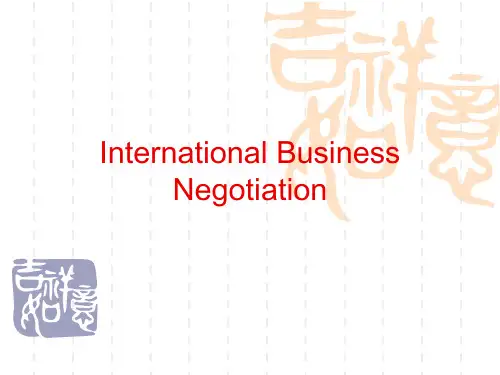
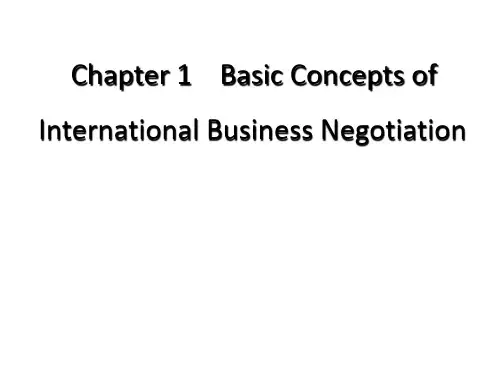
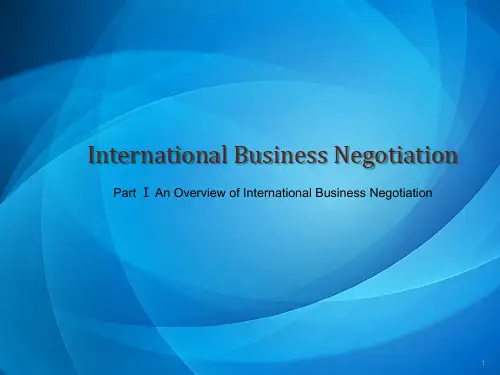
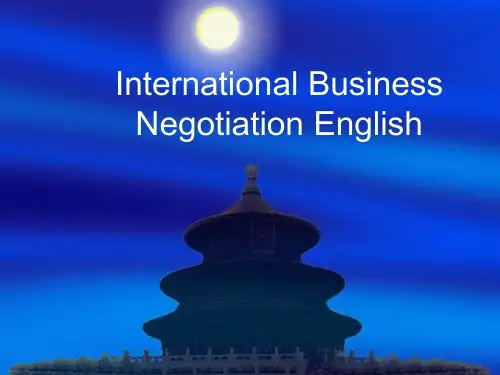
Chapter 1 International TradeI.WARM UP1.Divide students into three groups to discuss the followingtopics according to their real life:1)reasons for international trade2)benefits of international trade3)problems in international trade2.Ask each group to report their opinions to the class.3.The teacher estimates each group’s conclusion.II.INTRODUCE TWO THEORIES1.The principle of absolute advantage1)Introduce Adam Smith and The Wealth of Nations onPPT.2)Introduce the principle of absolute advantage withexamples.3)Ask students to translate the fourth paragraph onpage 3 in groups and pick one group to report theirtranslation.2.The principle of comparative advantage1)Introduce David Ricardo and On the Principles ofPolitical Economy and Taxation on PPT.2)Introduce the principle of comparative advantage withexamples.3)Ask students to translate the fourth paragraph onpage 3 in groups and pick one group to report theirtranslation.III.Homework1.Translate passages on page 1,2,6,7.2.Master the following terms and expressions:absolute advantage; comparative advantage; provided;abide by; production efficiency; productivity; hot cakes;infant industryChapter 1 International TradeI. ReviewAnswer the questions for review and further study:1.what are the reasons for international trade?2.What is the principle of comparative advantage?3.What are the benefits of international trade? Can you lista few examples from your daily life?II. Methods of restrictions1.TariffsExplain the following tariffs with examples on the PPT. Protection tariff 保护税率revenue tariff 财政性关税税率Import duty 进口税率export duty 出口税率Import surtax 进口附加税countervailing duty 反补贴税Anti-dumping duty 反倾销税variable levy 差额税Specific duty 从量税ad valorem duty 从价税Mixed & compound duty 混合/综合税Alternative duty 选择税2.Non-tariff barriersExplain the following non-tariff barriers with examples onthe PPT.Quota 配额import license 进口许可证Voluntary export restraints 自愿出口限制foreign exchange control 外汇管制state monopoly of import and export国家进出口垄断government procurement policy 政府采购政策advanced deposit 进口押金制度technical standards 技术标准health & sanitary regulations 健康和卫生规定packaging and labeling regulations 包装和商标规定minimum price 最低限价III.Homework1.Master the following terms:Quota; import license; Import duty;export duty;countervailing duty; anti-dumping duty; variable levyspecific duty; ad valorem duty; technical standardsforeign exchange control2.Do exercises on page 14-15.Chapter 2 Terms of Delivery I.ReviewReview the expressions and terms in chapter 1.II. Three sets of rules1.Warsaw-Oxford Rules 19321.1Initially in 1928---―Warsaw Rules, 1928‖22 provisions governing the rights and obligations ofthe parties to a sale of goods on CIF (Cost, Insuranceand Freight) contract terms.1.2 Revised in 1932---the ―Warsaw-Oxford Rules 1932‖21 provisions again mainly about CIF2.Revised American Foreign Trade Definitions 1941Defines 6 terms:Ex Point of Origin FOB (free on board)FAS (free alongside) C&F (Cost and Freight)CIF (Cost, Insurance and Freight)Ex Dock (Named Port of Importation3.International Rules for the Interpretation of TradeTerms 2000(Incoterms 2000)4.1936--- first created by International Chamber ofCommerce (ICC)4.1The purposes of incoterms:a)To give the businessmen a set of international rulesfor the interpretation of the most commonly usedtrade termsb)To clarify the obligations of the buyer and the sellerc)To simplify the contract negotiationsd)To save time and cost4.2 Revised in 1953、1967、1976、1980、1990、20004.3 Incoterms 2000 includes 13 terms under 4 groups III. Basics of Incoterms 20001.Scope of Governance●Parties involved: concerning only 2 parties -- seller &buyer●Document applied: only to the contract of sale●Specific aspects governed: only settle mattersconcerning the delivery of tangibles goods soldFocusing only on the delivery of tangible goodsDelivery also indicating the transfer of obligations, cost and risk distribution betweenthe parties●ObligationObligation -- a legal duty to do something according to a certain agreement.universally accepted obligation, eg:●the seller -- provide goods in conformitywith the contract●The buyer -- pay the price as stipulated inthe contractother obligations: handle the customs clearance, carriage of goods, insurance●Costlocal and overseas transportation and insurance costsgoods checking and inspection expenses, customs clearance chargesloading and unloading charges of the goods atsome particular transport points●Transfer of risk―Risk‖ refers to accidental damage to the goods.time: when does the risk pass from the sellers to the buyers?IV.Homework1.Master the following terms:Customs clearance; repeat orders; title to goods;Incoterms;2.Do exercises on page 33, 34.Chapter 2 Terms of DeliveryI. ReviewReview the terms and concepts of last part.II. Categorization of Terms●13 terms into four categories"E"-term—the seller only makes the goods available to the buyer at the seller's own premises."F"-terms — the seller is called upon to deliver the goods to a carrier appointed by the buyer."C"-terms — the seller has to contract for carriage, but without assuming the risk of loss or damage to the goods or additional costs due to events occurring after shipment or dispatch."D"-terms — the seller has to bear all costs and risksneeded to bring the goods to the place of destination III.Brief of Incoterms1.The ―E‖ term (EXW)●Seller’s obligation min.●Placing the goods at the disposal of the buyer at theagreed place – usually his own premises●In practice, also including assisting the buyer inloading the goods on the buyer’s collecting vehiclewithout charging a loading fee●For the buyer to get lower price, but too demandingfor him, therefore only applied to buyers havingoffshore branches●Delivery: at seller’s premises●Transfer of risks: goods at the disposal of the buyer●Packaging and loading:●Usu. seller no obligation for export packaging andloading;●Export customs clearance●Usu. buyer’s responsibility, sometimes buye r do it forbuyer, but bear no risks2.The “F” terms (FCA, FAS, FOB)●Shipment contract●Seller delivers the goods for carriage as instructed bythe buyer●buyer pays freight and signs carriage contract withcarrier and notify seller●FAS & FOB only for sea or inland waterwaytransportation mode●Seller’s obligation, cost and risk transfers to buyerafter delivery of the goods●Seller – exporting license and export customsclearance●Buyer – importing license and import customsclearance3.FCA Free Carrier (…. Named place)●Transfer of risksa)goods at the disposal of the (1st) carrier●Delivery pointb)If at seller’s site, seller responsible for loadingc)If anywhere else, seller responsible for delivering thegoods to the point required, but not responsible forunloading or reloading4.FAS Free Alongside Ship (…named port of shipment)●Transfer of risksa)goods at the disposal of the (1st) carrier●Delivery pointb)If at seller’s site, seller responsible for loadingc)If anywhere else, seller responsible for delivering thegoods to the point required, but not responsible forunloading or reloading5.FOB Free on Board (… named port of shipment)●Delivery point: at port of shipment●Transfer of risks: goods pass over the ship’s rail●Cost and obligation: the seller is paying for thenecessary handling of goods until they are loadedonboard the vessel.●Strictly speaking, transfer of risks ≠ transfer ofobligation and costIV.Homework1.Master terms of group E and group F.2.Remember the trade terms.Chapter 2 Terms of DeliveryI. ReviewReview the terms of group E and group F.II. The “C” terms (CFR, CIF, CPT, CIP)1.CFR Cost and Freight (… named port of destination)●Shares every feature with FOB except for oceanfreight charge●Freight at seller’s costSeller pay the normal transport cost for the carriage of the vessel by a usual route and in acustomary manner to the agreed placeBuyer take the risk of loss or damage to thegoods and additional costs resulting from eventsoccurring after the delivery of the goods●Obligation: seller’s respons ibilityfor booking shipping space and getter goodsready for shipment in due timeto notify to buyer about the delivery of goods (Shipping advice) so as to facilitate buyer tofulfill insurance proceduresNote: notification is more important under CFR thanunder FOB and CIF2.CIF Cost, Insurance and Freight (… named port ofdestination)●One step forward from CFR●Insurance born by sellerInsurance for the buyerThe seller pays for the insurance, but he does not take the risk of the cargo.●Seller responsible for ―min. coverage‖●If required by buyer and at buyer’s expense,additional coverage such as war, strike can be added●Seller has no responsibility to guarantee the arrival ofthe goods at the destination3.CPT C arriage Paid to (… named place of destination)●CPT is similar to CFR●Differences:Mode of transport●CPT – any mode●CFR – Sea or Inland WaterwayDelivery point●CPT – inland place or port of shipment●CFR – port of shipmentTransfer of risks●CPT – goods delivered to carrier●CFR –goods pass over ship’s rail4.CIP Carriage and Insurance Paid to (… named place ofdestination)●CIP is similar to CIF●Differences:Mode of transport●CIP – any mode●CIF – sea or inland waterwayDelivery point●CIP – Inland place or port of shipment●CIF – port of shipmentTransfer of risks●CIP – goods at the disposal of carrier●CIF –goods passing ship’s railFreight and insurance●CIP – whole journey freight and insurance●CIF – voyage freight and insuranceIII. Variation●FOB Liner Terms (FOB班轮条件)●FOB Under Tackle (FOB吊钩下交货)●FOB Stowed & Trimmed(FOB理舱,平舱费在内)●CFR/CIF Liner Terms (班轮条件)●CFR/CIF Landed (卸至码头)●CFR/CIF Ex Tackle (吊钩下交接)●CFR/CIF Ex Ship’s Hold (舱底交接)IV. HomeworkMaster the terms of group F.。
国际商务谈判International Business NegotiationA negotiation is a meeting or a series of meetings in which the parties need each other’s agreement to reach a specific objective.The fundamental principles of negotiation1. Negotiation is an element of human behavior.2. Negotiation takes place only over issues that are negotiable.3. Negotiation takes place only between people who have the same interest.4. Negotiation takes place only when negotiators are interested not only in taking but also in giving.5. Negotiation takes place only when negotiating parties trust each other to some extent.Chapter 1 Negotiation motives and key terminology 谈判动机与关键词语Negotiation谈判Conflicts冲突Stakes利益Case study: Matsushita Electric Corporation 松下电器公司————————————————————————————————————NEGOTIATION谈判A successful negotiation must satisfy at least the following conditions:1. The outcome of negotiation is a result of mutual giving and taking. One sided concession or compromise can not be called a successful negotiation.2. Negotiations happen due to the existence of conflicts, however, no negotiations can proceed smoothly and come to a satisfactory solution without collaboration between the participants.3. Negotiation is a behavioral process, not a game; in a good negotiation, everybody wins something. Success isn’t winning everything; it’s winning enough.CONFLICTS冲突The definition of conflicts states three points:1. Parties in conflicts are interdependent, which means there remains a kind of relationship developed by interrelated interests and concerns. There would be no conflict if two parties were not interrelated and had nothing to do with each other.2. Contradictions and interests coexist. If there are only contradictions and no sharing of common interests, negotiations become groundless and unnecessary.3. Two parties in a conflict will naturally fight for each other’s own interests and make every effort to gain more from the other side, as a result it will reduce gain of interests expected initially.STAKES利益Stakes are the value of benefits that may be gained or lost, and costs that may be incurred or avoided. Four points need to be clarified:1. Negotiation parties will either gain the interests they expect to win from the negotiation or lose what they hope to attain, which indicates that the talks are pertinent to relevant parties’ own affairs and interests. Only when a party has stakes connected with the issues to be talked, can it become actively engaged in the negotiation.2. Free lunch is not provided at the negotiation table, in another word, to get what is desired, both parties have to pay for the gaining at either high cost or low cost depending on how well negotiators manage the situation.3. The negotiators will have to decide how much of stakes can be gained and whether a particular gain is the one that a party desires for. They will also have to decide how much they may gain if they choose option A instead of option B.4. Negotiators will have to compare and balance the relation between the current interests and long term interests or underlying desires in order to make decision on satisfying long term interests at the cost of current interests.Effective negotiating (VCD)成功谈判Who’s who in Effective NegotiationThe companiesLevien SA , based in Brussels, Belgium.It is an international company which manufactures specialist paints and dyes.In its head office it has a small IT function which the company has decided to outsource.Okus IT, based in Swindon, in the South of England.They specialize in managing IT projects and taking over the IT departments of their client companies.The negotiationOkus have sent a detailed written proposal to Levien.The meeting has been arranged to negotiate the terms of any agreement.In particular the following two issues are likely to be sticking points:1. StaffingLevien would like to protect the jobs of their current IT team.They want Okus to employ the four members of the team, and are under pressure from the unions to make sure outsourcing contracts like this do not lead to redundancies. Okus, on the other hand, will not want to take on Levien’s whole team.They already have project engineers based in Swindon.2. PricingOkus have proposed two levels of IT support:Level AA fixed monthly price which will cover all support work (daily maintenance and customer support) and specified project work (hardware and software upgrades, training. Etc.)Level BA lower monthly invoice based on just support work. Any additional project work will be logged and then added to the invoice the following month.1.Preparing the groundThe peopleAndrew Carter is Export Sales Manager for Okus IT. He has made the initial contact with Levien. He has met one of the Levien team, Sean, before.Karen Black is a Project Manager at Okus IT. She has prepared the specifications for this contract. This is the first time she has been involved in negotiating an overseas outsourcing contract. She is anxious about the meeting.Francoise Quantin is the current IT Manger at Levien. She is about to be promoted to Head of Logistics. She is keen that her IT team are protected.Sean Morrissey is from Levien’s main subsidiary in Chicago. He has been sent to the Brussels Off ice to develop Levien’s procurement policy.The negotiationAs the VCD begins, Andrew and Karen have arrived at Levien’s offices and are waiting to meet Francoise and Sean.Script 1Karen Black and Andre Carter fail to communicate before they meet the Levin team.A =Andrew K =Karen F =Franςoise S =SeanA: You sure you don’t want one, Karen?K: Not for me.A: Of course, I don’t know Francoise at all, but you’ve got to ____ with Sean. I toldyou about negotiating with him in Dalla s two years ago, didn’t I?K: I’m sure you did, Andrew. Can we just focus on the final package? We mustn’t ____. They’re going to ____, but we ____.A: That’s right. Sean was Head of Procurement at TEC in Atlanta.K: What we must keep in mind is ____ if they push us on staff cuts.A: Oh, we don’t need to worry about that, Karen. We’ll just ____. Sean, how are you? S: Good to see you again, Andrew. Atlanta, wasn’t it?A: Dallas, actually.S: Right, three years ago.A: Two.S: Yeah, sure. You two know each other, right?F: You must be Karen Black. I’m Francoise Quantin. Welcome to Lebvien.K: We’ve spoken on the phone, haven’t we? This is Andrew Carter, our ____.A: Sorry, I thought you two already knew each other.S: Well, ____. Can we…?F: Before we start, would you like a coffee?K: That would be nice.F: Milk?K: Yes, please.Script 2Karen Black and Andre Carter are better prepared for their meeting with the Levin team.A: There you go.K: thanks.A: So, we’ll wait for t hem to respond to our proposal.K: Yes, we know that the staff cuts and the price are ____, but we’d better ____.A: And you’d still like me to do the presentation?K: That’s what we head-hunted you for, Andrew.A: And you’ll watch for their reactions and …K: And deal with any questions. Yes.A: Be careful with Sean, Karen. He drives a hard bargain.K: I’m sure I can handle him. We’re in for a long day, aren’t we?A: Well, you did pack a toothbrush, didn’t you?F: Sorry to have kept you waiting. You must b e Karen Black. I’m Francoise Quantin and this is Sean Morrissey.S: Good to meet you, Karen. Francoise, this is my old sparring partner, Andrew Carter. F: Nice to meet you, Andrew. How was your flight?K: Excellent. Less than an hour.A: Hardly time for the breakfast____.F: What about a coffee then, before we start?S: Yeah, you can ____.F: There’s no need to hurry. Karen.S: Andrew, you’ll have another one?A: Please. Milk, three sugars.F: Sit down, please.A: Are you ____, Sean?S: Yeah, I’m missing t he kids and my wife. Andre and I ____in Dallas two years ago. A: Yes, ____---thirty-six hours, wasn’t it?S: Andrew, if a job’s worth doing, _____.F: Perhaps we had better start now.。